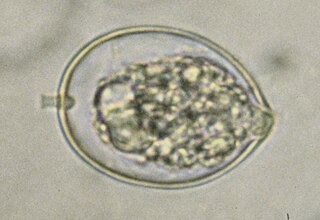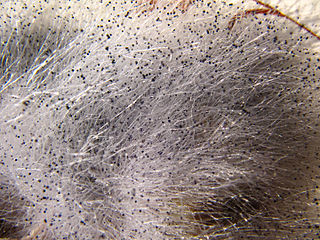
A fruit tree is a tree which bears fruit that is consumed or used by animals and humans — all trees that are flowering plants produce fruit, which are the ripened ovaries of flowers containing one or more seeds. In horticultural usage, the term "fruit tree" is limited to those that provide fruit for human food. Types of fruits are described and defined elsewhere, but would include "fruit" in a culinary sense, as well as some nut-bearing trees, such as walnuts.

Mucor is a microbial genus of approximately 40 species of molds in the family Mucoraceae. Species are commonly found in soil, digestive systems, plant surfaces, some cheeses like Tomme de Savoie, rotten vegetable matter and iron oxide residue in the biosorption process.

Phytophthora cactorum is a fungal-like plant pathogen belonging to the Oomycota phylum. It is the causal agent of root rot on rhododendron and many other species, as well as leather rot of strawberries.

Monilinia laxa is a plant pathogen that is the causal agent of brown rot of stone fruits.

Penicillium expansum is a psychrophilic blue mold that is common throughout the world in soil. It causes Blue Mold of apples, one of the most prevalent and economically damaging post-harvest diseases of apples.
Cadophora malorum is a saprophytic plant pathogen that causes side rot in apple and pear and can also cause disease on asparagus and kiwifruit. C. malorum has been found parasitizing shrimp and other fungal species in the extreme environments of the Mid-Atlantic Ridge, and can be categorized as a halophilic psychrotrophic fungus and a marine fungus.

Podosphaera leucotricha is a plant pathogen that can cause powdery mildew of apples and pears.
Ceratocystis paradoxa or Black Rot of Pineapple is a plant pathogen that is a fungus, part of the phylum Ascomycota. It is characterized as the teleomorph or sexual reproduction stage of infection. This stage contains ascocarps, or sacs/fruiting bodies, which contain the sexually produced inoculating ascospores. These are the structures which are used primarily to survive long periods of time or overwinter to prepare for the next growing season of its host. Unfortunately, the sexual stage is not often seen in the natural field but instead the anamorph, or asexual stage is more commonly seen. This asexual stage name is Thielaviopsis paradoxa and is the common cause of Black rot or stem-end rot of its hosts.
Alternaria citri is a fungal plant pathogen that causes black rot in citrus plants.

Glomerella cingulata is a fungal plant pathogen, being the name of the sexual stage (teleomorph) while the more commonly referred to asexual stage (anamorph) is called Colletotrichum gloeosporioides. For most of this article the pathogen will be referred to as C. gloeosporioides. This pathogen is a significant problem worldwide, causing anthracnose and fruit rotting diseases on hundreds of economically important hosts.
Monilinia fructigena is a plant pathogen in the fungus kingdom causing a fruit rot of apples, pears, plums, peaches and cherries.
This article summarizes different crops, what common fungal problems they have, and how fungicide should be used in order to mitigate damage and crop loss. This page also covers how specific fungal infections affect crops present in the United States.
Pineapple black rot, also known as butt rot, base rot, or white blister, is a disease caused by Ceratocystis paradoxa (teleomorph). C. paradoxa also causes disease in a variety of other tropical plants such as banana, coconut, and sugarcane making it a somewhat dangerous pathogen. Pineapple black rot is the most common and well-known post-harvest disease of the pineapple fruit and is responsible for serious losses in the fresh pineapple fruit world industry. The pathogen is a polyphagous wound parasite and gains entry into the fruit via wounds sustained during and after harvest. The disease only shows up in fresh fruit because the time from harvest to processing it too short for infection occur. Infection can also occur out in the field, but it is not nearly as common as post-harvest infection.
A species of the genus of Penicillium which causes Blue Mold of Garlic on Allium sativum L. The genus name is derived from the Latin root penicillum, meaning "painter's brush", and refers to the chains of conidia this fungus produces that resemble a broom.

Trichothecium roseum is a fungus in the division Ascomycota first reported in 1809. It is characterized by its flat and granular colonies which are initially white and develop to be light pink in color. This fungus reproduces asexually through the formation of conidia with no known sexual state. Trichothecium roseum is distinctive from other species of the genus Trichothecium in its characteristic zigzag patterned chained conidia. It is found in various countries worldwide and can grow in a variety of habitats ranging from leaf litter to fruit crops. Trichothecium roseum produces a wide variety of secondary metabolites including mycotoxins, such as roseotoxins and trichothecenes, which can infect and spoil a variety of fruit crops. It can act as both a secondary and opportunistic pathogen by causing pink rot on various fruits and vegetables and thus has an economical impact on the farming industry. Secondary metabolites of T. roseum, specifically Trichothecinol A, are being investigated as potential anti-metastatic drugs. Several agents including harpin, silicon oxide, and sodium silicate are potential inhibitors of T. roseum growth on fruit crops. Trichothecium roseum is mainly a plant pathogen and has yet to show a significant impact on human health.

Cladosporium cladosporioides is a darkly pigmented mold that occurs world-wide on a wide range of materials both outdoors and indoors. It is one of the most common fungi in outdoor air where its spores are important in seasonal allergic disease. While this species rarely causes invasive disease in animals, it is an important agent of plant disease, attacking both the leaves and fruits of many plants. This species produces asexual spores in delicate, branched chains that break apart readily and drift in the air. It is able to grow under low water conditions and at very low temperatures.

Rhizopus stolonifer is commonly known as black bread mold. It is a member of Zygomycota and considered the most important species in the genus Rhizopus. It is one of the most common fungi in the world and has a global distribution although it is most commonly found in tropical and subtropical regions. It is a common agent of decomposition of stored foods. Like other members of the genus Rhizopus, R. stolonifer grows rapidly, mostly in indoor environments.

Bitter rot of apple is a fungal disease of apple fruit that is caused by several species in the Colletotrichum acutatum and Colletotrichum gloeosporioides species complexes. It is identified by sunken circular lesions with conical intrusions into the apple flesh that appear V-shaped when the apple is cut in half through the center of the lesion. It is one of the most devastating diseases of apple fruit in regions with warm wet weather.
Mucor fragilis is an endophytic fungus that causes the mold that can be found on grapes, pole beans, loquat, and on the roots of medicinal plants like Radix pseudostellariae. It belongs to the order Mucorales and phylum Mucoromycota. The observed symptoms showed the presence of fluffy and soft fungal mycelium with white to dark brown discoloration that deteriorated the beans and grapes quality.
Lambertella corni-maris is a small ascomycete fungi. It grows in deciduous fruit areas, and causes postharvest Lambertella rot on apple fruits. The species also forms a mycoparasitism relationship with Monilinia fructigena. It is the type species of the genus Lambertella.










